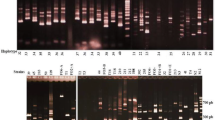Abstract
Worldwide, wastewaters constitute a major environmental pollutant. They are very toxic against a wide range of plants and soil microorganisms. Their toxicity is due to the presence of compounds such as polyphenols. In this study, we have isolated yeast strains from the endogenous microflora of the olive fliesBactrocera oleae larvae that were capable of degrading the olive oil mill wastewater polyphenols. The results obtained showed the presence, in the digestive tract of the larvae, of yeast strains resisting to polyphenols. Two resistant strains were isolated and have shown variable capacity of polyphenols degradation that could reach up to 72%. The two isolated strains were identified by two methods: conventional technique and molecular method associating PCR amplification and DNA sequencing of the 5.8S ribosomal RNA gene. Both techniques showed that the two isolated strains corresponded to theCandida diddensiae specie. Related to its capacity to degrade polyphenols, this specie would be a potential candidate for wastewater treatment and environmental protection.
Similar content being viewed by others
References
Aissam H., Errachidi F., Merzouki M., Benlemlih M. (2002). Identification des levures isolées des margines et étude de leur activité catalase. Cahiers de l’Association Scientifique Européene pour l’Eau et la Santé, 7 (1): 23–30.
Aissam H. (2003). Etude des Effluents des Huileries de la Ville de Fès (margines): Caractérisation, Biotraitement et Valorisation. Thèse pour l’obtention du diplôme de Doctorat National. Faculté des Sciences Dhar Elmahraz, Fes.
Barnett J.A., Payne R.W., Yarrow D. (2000). Yeasts: Characteristics and Identification, 3rd edn., Cambridge University Press, UK.
Cavados C.F.G., Fonseca R.N., Chaves J.Q., Rabinovitch L., Araujo C.J.P.C., Coutinho. (2001). Identification of entomopathogenicBacillus isolated fromSimulium (Diptera, Simuliidae) larvae and adults. Mem. Inst. Oswaldo Cruz, Rio de Janeiro, Vol. 96 (7): 1017–1021.
Drik R. (2000). Specific PCR primers to identify arbuscular mycorrhizal fungi within colonized roots. Mycorrhiza, 10: 73–80.
Ehaliotis C., Papadopoulou K., Kotsou M., Mari I., Balis C. (1999). Adaptation and population dynamics ofAzotobacter vinelandii during aerobic biological treatment of olive-mill wastewater. FEMS Microbol. Ecol., 30: 301–311.
Fadil K., Chahlaoui A., Ouahbi A., Zaid A., Borja R. (2003). Aerobic biodegradation and detoxification of wastewaters from the olive oil industry. Int. Biodet. Biodegrad., 51: 37–41.
Fiesta Ros De Urisinos J.A., Borja-Pdilla R. (1996). Biomethanization. Int. Biodeterior. Biodegrad., 38: 145–153.
Garcia Garcia I., Jiménez Pena P.R., Bonilla Venceslada J.L., Martin Martin A., Martin Santos M.A., Ramos Gomez E. (2000). Removal of phenol compounds from olive mill wastewater usingPhanerochaete chrysosporium, Aspergillus niger, Aspergillus terreus andGeotrichum candidum. Proc. Biochem., 35: 751–758.
Kahraman S., Yesilada O. (1999). Effect of spent cotton stalks on color removal and chemical oxygen demand lowering in olive oil mill wastewater by white rot fungi. Folia Microbiol., 44: 673–676.
Kreger-Van R.I.J. (1987). The Yeasts a Taxonomic Study, Third Revised and Enlarged Edition, Elsevier Science Publishers. B.V., Amsterdam, The Netherlands.
Maestro-Duran R., Borja R., Martin A., Fiestas Ros de Ursinos J.A., Alba Mendoza J. (1991). Biodegradation de los compuestos fenolicos presentes en el alpechin. Grasas Y Aceites, 42: 271–276.
Martirani L., Giardina P., Marzullo L., Sannia G. (1996). Reduction of phenol content and toxicity in olive mill wastewaters with the ligninolytic fungusPleurotus ostreatus. Water Res., 1 (30): 1914–1918.
Mendia L., Carbone P., Dantonio G., Mendia M. (1986). Treatment of olive oil wastewaters. Water Sci. Technol., 18: 1254–1256.
Moreno E., Quevedo-Sarmiento J., Ramos-Cormenzana A. (1990). Antibacterial activity of wastewaters from olive mills. In: Cheremisinoff P.N., Ed., Hazardous Waste Containment and Treatment, Vol. IV, Gulf Publications, USA, pp. 731–757.
Perez J., Esteban E., Gomez M., Gallardolara F. (1986). Effects of wastewater from olive processing on seed germination and early plant growth of different vegetable species. J. Environ. Sci. Health, 21: 349–357.
Piperidou C.I., Chaidou C.I., Staliskas C.D., Soulti K., Pilidis G.A., Balis C. (2000). Bioremediation of olive oil mill wastewater: Chemical alterations induced byAzotobacter vinelandii. J. Agric. Food Chem., 48: 1941–1948.
Rodier J. (1996). L’Analyse de l’Eau: Eaux Naturelles, Eauxrésiduaires, Eaux de Mer, 8eme èdition. Dunod, Paris.
Sayadi S., Ellouz R. (1992). Decolorization of olive mill wastewaters byPhanerochaete chrysosporium, involvement of the lignin degrading system. Appl. Microbiol. Biotechnol., 37: 813–817.
Servis D. (1986). The soil as a receiving body of olive oil mill wastewaters (in Greek). M. Sc. Thesis, Agricultural University of Athens.
Yesilada O., Sik S., Sam M. (1998). Biodegradation of olive oil mill wastewater byCoriolus versicolor andFunlia trogii: effects of agitation, intial COD concentration, inoculum size and immobilization. World J. Microbiol. Biotechnol., 14: 37–42.
Yesilada O., Sik S., Sam M. (1999). Treatment of olive oil mill wastewater with fungi. Tr. J. Biology, 23: 231–240.
Author information
Authors and Affiliations
Corresponding author
Rights and permissions
About this article
Cite this article
Chakri, M., El Haidani, A., El Mzibri, M. et al. Yeast strains from the endogenous microflora of the olive fliesBactrocera oleae larvae which could degrade the olive oil mill wastewaters polyphenols. Ann. Microbiol. 57, 143–147 (2007). https://doi.org/10.1007/BF03175199
Received:
Accepted:
Issue Date:
DOI: https://doi.org/10.1007/BF03175199




